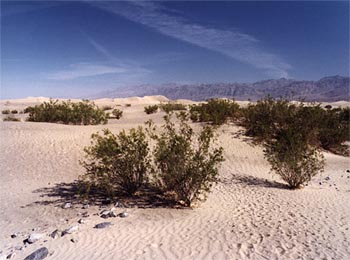|
The forces that shape the dunes are the same ones that
created them in the first place. Sand dunes are created by winds that come
in from different directions. When these winds converge, they drop their
loads of sand. If the wind blew in the same direction the sand would just
move on and would never accumulate.
The dunes near Stovepipe Wells are the largest in Death
Valley, but are not particulary large as far as sand dunes go. The highest
dune in the valley is about 140 feet thick. Dunes found farther south in
the Imperial Valley are about three times as large. Still, Death Valley's
dunes are impressive not just for the sand, but for the setting.
A hike into the dunes reveals some interesting details.
Large green creosote mesquite bushes greet you as you approach the dunes.
These bushes thrive on the moisture the dunes lock in. Rainwater percolates
deep into them and the sand on the outside of them dries out. This process
provides insulation for the moisture within.
Once in the dunes it's hard to resist the urge the play
in the sand. In digging in the dunes, I discovered multicolored layers of
sand. I asked Glazner about what I had seen and he told me, "What you
saw are layers of cross beds that have been cemented a little bit by water
percolating through and depositing gypsum or calcium carbonate, which sticks
the sand grains together a little bit. You also might have seen dark layers
that represent deposits of really dense minerals like magnetite and garnet
that don't blow around as easily and tend to concentrate in the low spots."
These layers are sometimes preserved in sandstone rocks that are millions
of years old.
Occasionally, sandstone will show the ripples that are often found on the
outside of the dunes. Ripples are not only beautiful, they are also revealing.
They can tell us which direction the wind was blowing on the surface when
they were formed, how strong the wind was, and even how coarse the sand
is. Apparently, the size of the ripples varies depending on the coarseness
of the grain and the strength of the wind.
 According to
"Geology Underfoot," which Glazner coauthored with Robert Sharp,
most ripples are relatively small, "from 3 to 8 inches from crest to
crest--which is known as the ripple's wavelength." These wavelengths
increase from 18 to 24 inches in coarse sand found near the center of Mesquite
dunes.
According to
"Geology Underfoot," which Glazner coauthored with Robert Sharp,
most ripples are relatively small, "from 3 to 8 inches from crest to
crest--which is known as the ripple's wavelength." These wavelengths
increase from 18 to 24 inches in coarse sand found near the center of Mesquite
dunes.
|